Farmers markets are growing in number, and quickly! Farmers, shoppers and city planners are discovering that these markets provide a vital link between consumers and farmers while also functioning as a vibrant community center. Consumer trends are showing an ever-increasing demand for fresh, healthy, locally grown food.
This page offers information and tips on how farmers markets can be a profitable, and enjoyable, part of your farm business.
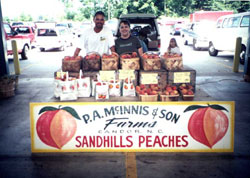 Farmers Market Advantages
Farmers Market AdvantagesStart Up
A significant advantage of farmers markets is that they are generally situated in an ideal location to reach consumers. The fees for a space are usually very minimal and most regulations and restrictions – like zoning, sign, health department, and business license – are already worked through by the sponsoring group. Little or no packaging is required. All you really need is a creative, clean display and a truck!
Publicity for Your Farm
Farmers markets allow you to interact with customers, educating them about your farm and how food is grown. You get a chance to pitch your product to the customer. Since most farmers don’t use the farmers markets as their only outlet, it also becomes an opportunity to promote other aspects of your business, such as Community Supported Agriculture (CSA) arrangements, roadside stands, pick-your-own, deliveries to local restaurants, agritourism, etc.
Customer/Farmer Feedback
Feedback from customers is almost immediate. Customers are your most valuable link to market trends and demands. They can offer new product or marketing ideas. If you’re unsure how a new variety might sell, experiment with a small amount before committing to production on a larger scale.
Feedback from other growers and vendors is equally valuable. Growers can share information on crops, growing techniques, market ideas and cooking.
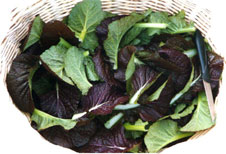 Things to Consider
Things to ConsiderThere are important considerations to be made before deciding to sell at a farmers market. Along with other direct marketing methods, marketing your product requires time, often time away from the farm. Be sure to consider the time it will take not only to sell your product at the market, but also loading up, traveling to the market, unloading, and setting up and breaking down a display.
Consider the fact that volume is limited. Like other direct marketing outlets, few people sell their products in high volume at farmers markets. This is one reason why farmers markets usually are only a part of the entire business operation. Having other market outlets during the week allows you to sell your farm product as it matures/ripens.
Other factors to consider are the markets policies in regard to space, advertising, market hours, etc. Be sure to visit a potential farmers market before selling there and observe the attendance, layout, and facilities at different times of the year. Customer attendance can be erratic, often affected by the weather and holidays.
The location of the farmers market should be another consideration. Is it located near well populated areas? Is it difficult to get to? Are there other attractions or businesses near the market that draw people to the area?
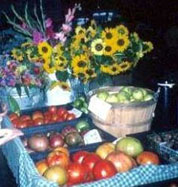 Displays/Signs
Displays/SignsDisplay
Proper design and creativity are important to attract customers and increase sales. The display is what the customer sees first. Convey a sense of pride in your product and appear ready for business.
A good display does not have to be expensive. There are certain rules of thumb to consider in any display. Keep the display off the ground, preferably at waist level. Prop boxes or baskets at a slant toward the customer. Give your display the illusion of abundance. Make it appear as though your product is spilling out. This may mean switching to smaller containers as your stock decreases. Constantly re-stock your containers. No one wants to think they’re buying the last few tomatoes. Make sure all items are clearly visible and easy to reach. Use props from home/farm to create your display. Listed below are some effective techniques:
Labeling
Clearly label all products with the name (including variety) and the item’s price. Small index cards and magic markers are useful for general labeling. Be neat and creative.
Options:
Signs
A good sign is a must at a farmers market. A sign with your farm name (and logo) identifies you so people can find you again and tell their friends how to find you. Have photos and information about your farm available for consumers to see and learn about your farm.
Sign Tips:
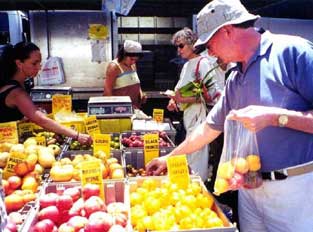 What to Sell
What to SellQuality products are the key to making money at the farmers market! Consumers are interested in fresh, local, and diverse products. Selecting from a wide variety of standard and specialty products keeps customers satisfied and returning for more.
Try to find your niche. Remember there are others selling at the market too, not everyone can sell German Johnson tomatoes. When possible, bring something new to the market each week to retain customer interest.
Try to avoid having limited amounts of too many items to avoid selling out before the end of the day. Products sell better when they look plentiful. The key is to go home with a full wallet rather than an empty truck.
As much as possible, try to have crops available early and late in the season. One sure way to make money is to get the jump on everyone else. By offering tomatoes early in the season, before other growers, you can assure yourself an early share of the market and lots of customers.
Food can go in and out of style. Keeping abreast of consumer trends is another way to make the most out of your time at the market. What was a big seller this year may not be so hot next year. Look at cooking and restaurant magazines to see to see what’s “in”. Try different, unique varieties of common products to catch people’s attention.
Value-added items, such as baked goods and canned goods, help to supplement farm income from the sale of fresh farm products, especially during the off season. Products such as jellies and salsas can be a great way to get rid of leftover or less than perfect produce. Keep in mind that production of some value added products can be costly. It usually requires special equipment and facilities, as well as added labor. There are also numerous legal restrictions and health regulations that need to be followed before selling your value-added product. Kitchens and cooking facilities have to be inspected and meet certain standards prior to selling at a market.
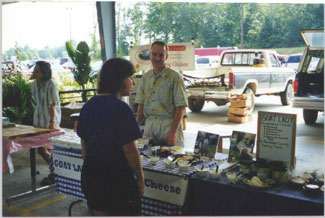 Pricing/Selling Tips
Pricing/Selling TipsPricing
The best way to establish your prices is to base them on the cost of production. You should never have to sell below supermarket prices. Remember that most people are not coming to the farmers market for inexpensive produce. The more you educate your customers about how a product is grown, the better they will understand your pricing system. You are offering a fresh, locally grown product that customers can’t get at a grocery store, so don’t be afraid to ask a premium price.
Posting all your prices for each product takes out the guess work for customers. Either have a board with all products and prices listed or individual labels affixed to baskets. Make sure to include both the price and unit ($1.50/lb., $2.00/bundle). Think about how you want to sell each product. Selling by the pound means having a scale on hand as well as a supply of bags. Many customers prefer to handle the products and pick them out themselves, rather than purchasing them pre-packaged.
Selling Tips
One of the main reasons people come to a farmers market is for the one-on-one contact between a customer and a farmer. Learning good selling techniques can help you establish customer relationships which lead to more sales. Bring a smile and stories to tell.
Engage your customers in conversation and educate them on your products and how they are grown. Make eye contact with them when you are talking and appear eager to serve them. Pay attention to your physical appearance as well. You want to project a clean, responsible, honest image, so dress accordingly.
A few other selling tips:
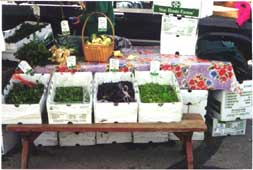 Rules and Regulations
Rules and RegulationsFarmers markets may be operated by state, county, or city governments as well as other organizations. Each will have their own rules and regulations regarding the items that can be sold and how. Most markets require that everything you sell must be produced by you. Others require that only some percentage of what is sold be produced by you. Market managers (and customers) strongly frown upon vendors selling products bought from wholesale or retail sources. Check with the market manager about arrangements for selling another local grower’s produce for them. Most farmers markets discourage a flea market atmosphere, while some may allow crafts to be sold.
Visit the farmers markets where you might want to sell your products and talk with the manager about rules and regulations. Check out the facilities, vendor spaces, attendance, and clientele to determine if this is a good place for you to sell and on which days of the week.
The U.S. Department of Agriculture publishes a helpful book on legal issues affecting direct farm marketing called, The Legal Guide For Direct Farm Marketing by Neil Hamilton. For information regarding rules and regulations at North Carolina state supported farmers markets, visit: growingsmallfarms.ces.ncsu.edu/growingsmallfarms-meatandeggs/ (additional resources linked Here). For a list of farmers markets in North Carolina, visit: www.ams.usda.gov/farmersmarkets/States/NorthCarolina.htm.
Listed below are various resources with information regarding farmers markets and other direct marketing methods:
Books
Corum, V., Gibson, E. & Rosenzweig, M. The New Farmers’ Market: Farm Fresh Ideas for Producers, Managers & Communities. 2001. New World Publishing.
Gibson, Eric. Sell What You Sow! The Grower’s Guide to Successful Produce Marketing.
1994. New World Publishing.
Hamilton, Neil. The Legal Guide to Direct Farm Marketing. 1999. United States Department of Agriculture.
Ishee, Jeff. Dynamic Farmers’ Marketing: A Guide to Successfully Selling Your Farmers’ Market Products. 1997. Bittersweet Farmstead.
Web Sites/Links
Appropriate Technology Transfer for Rural Areas (ATTRA): http://www.attra.org, 1-800-346-9140. USDA funded program offering publications and assistance on direct farm marketing.
This marketing record form will help you determine the true costs of producing and marketing a product. By keeping track of the time, labor and inputs required for each commodity, you will be able to tell which are profitable and which are not.
Download a copy of this form in Microsoft Word format
The NC Department of Agriculture & Consumer Services maintains a survey of prices for seasonal produce based on the average of prices at various state farmers markets. These prices may assist you in establishing prices for your products.